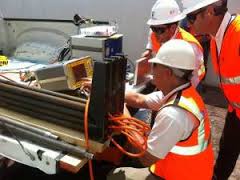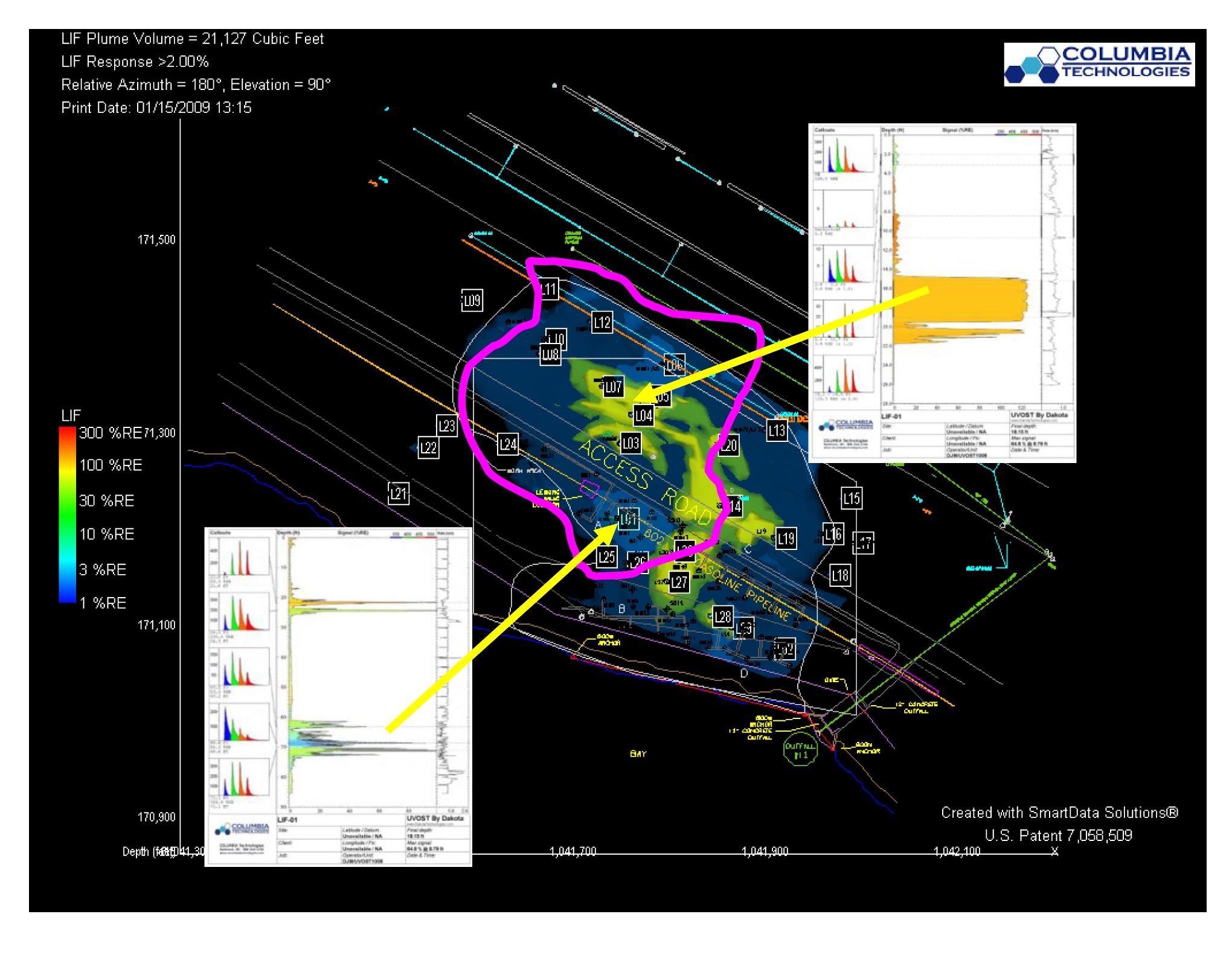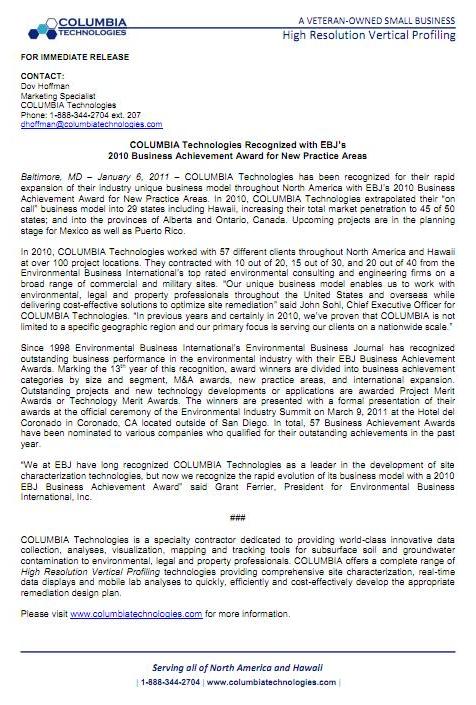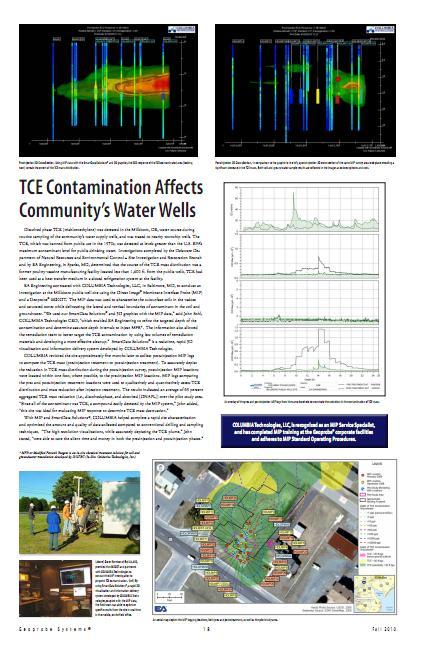The 7 Biggest Myths of Direct Sensing (Part I)
After 20 years in enviromental sampling and analysis we have come to believe in direct sensing as a...

After 20 years in enviromental sampling and analysis we have come to believe in direct sensing as a...

COLUMBIA Technologies recently supported the Sixth International Seminar on Environmental...

Article originally featured on Tradeology, the official blog of ITA (International Trade...

One of the most critical points to remember when developing a site closure work plan is that it...

Since 2008, our team at COLUMBIA Technologies has supported site managers in evaluating petroleum...

COLUMBIA Technologies recently completed the Veteran Institute Procurement (VIP), a comprehensive...

COLUMBIA Technologies is currently supporting our first high-resolution direct sensing project in...

Article originally featured in the Environmental Business Journal (EBJ) Remediation & Redevelopment...

COLUMBIA Technologies has been recognized for their rapid expansion of their industry unique...

Article originally featured in the Probing Times, the official newsletter of Geoprobe Systems® Fall...
After 20 years in enviromental sampling and analysis we have come to believe in direct sensing as a means of providing the most rapid and comprehensive information about the distribution and composition of soil and groundwater contamination. Ever evolving, today’s direct sensing tools for remediation focused site characterization projects continue to add a greater range of high resolution information on subsurface conditions including hydrology, lithology and contaminant distribution to support environmental liability decision.
Although direct sensing approaches are used throughout the environmental industry supporting cleanup and closure efforts, there are still several myths associated in applying these methods to site investigation and remediation projects.
There are three basic assumptions or principles we have in mind when deploying high resolution direct sensing tools with as near real time decision-making information:
Tags: Direct Sensing, News
COLUMBIA Technologies recently supported the Sixth International Seminar on Environmental Characterization and Remediation of Sites Impacted by Hydrocarbons - 2012 in Mexico City, Mexico. The seminar was hosted by Rede Latino Americana de Prevenção e Gestão de Sítios (ReLASC) in partnership with PEMEX Refinery and Ecoterra Servicios Ambientales.
On Friday, September 14, COLUMBIA presented Rapid High Resolution Site Characterization Using Direct Sensing Technologies. With local teaming partner, International Products and Organic Solutions (IPOS) on Saturday, September 15, COLUMBIA provided a hands-on demonstration displaying how these advanced tools can be applied to a wide range of contaminated sites.
For more information contact:
Tags: High Resolution Site Characterization (HRSC), LNAPL, News, Mexico
Article originally featured on Tradeology, the official blog of ITA (International Trade Administration)
Doug Barry is a Senior International Trade Specialist in the Trade Information Center, U.S. Commercial Service within the International Trade Administration.
John H. Sohl III is founder of Columbia Technologies, a Maryland company that maps underground pollution from large manufacturing facilities, oil terminals, pipelines and military bases. The company is a client of the Baltimore Export Assistance Center.
Barry: How do you map underground pollution?
Sohl: Mapping involves deployment of sensor technologies that track leakage and migration of pollutants. Following analysis by our technicians, customers can make decisions on risk assessment, disposition of the property and proper cleanup actions.
Sohl: I started the company about 15 years ago after doing similar work in the U.S. Navy. I was always intrigued with the application of sensors and three-dimensional mapping of components, and that’s the approach we brought to the industry. The world really is getting flat and many of our clients are global industries that have footprints both in the U.S. and North America as well as the globe. So once we’ve established a good working relationship and reputation with those firms, they sought to bring us into other parts of the globe.
Barry: So your initial market entry strategy was to piggyback on clients here in the U.S. and ride them into new markets.
Tags: High Resolution Site Characterization (HRSC), John Sohl, News, Brazil, Mexico
One of the most critical points to remember when developing a site closure work plan is that it simply costs too much to assess, remediate, and make decisions on information that is incomplete, inaccurate, and too late. Traditional approaches to characterizing subsurface conditions by drilling, soil sampling, and monitoring wells screened over large intervals are too incomplete to accurately deal with site heteregoneity.
Therefore, a high resolution site characterization approach is a more attractive option as it enables projects to move forward with remediation focused activities such as corrective action, free product recovery efforts, and site closure.
Let’s face it, the heterogeneity geology of a site is going to impact the migration of subsurface contamination opposed to the age old myth that it always follows the direction of groundwater. Introduction of the Hydraulic Profiling Tool (HPT) for site investigation and remediation efforts supports contaminant mapping activities to provide a greater understanding of subsurface conditions. By measuring direct pressure response, HPT develops weighted lines of evidence indicating the tight (or loose) grains and low (or high) flow zones in order to determine the migration pathways, remediation injection regions, and placements for monitoring wells. With an integrated Soil Electrical Conductivity (EC) array this tool also defines zones of lower conductivity which allows for the movement of contaminants into the subsurface.
Tags: Hydraulic Profiling Tool (HPT), LNAPL, Membrane Interface Probe (MIP), News, Site Characterization
Since 2008, our team at COLUMBIA Technologies has supported site managers in evaluating petroleum contamination at 125 and growing projects using direct sensing or imaging tools. These projects include a wide-range of application from gasoline and diesel fuel retail stations to Superfund sites, as well as petroleum terminals, petroleum storage facilities, pipeline terminals, railyards, oil refineries, complex underground storage tank (UST) sites, military installations, and truck refueling facilities. These sites have spanned across 28 states in the United States including Hawaii, and multiple provinces in Canada. One primary technology deployed at these sites is the Laser Induced Fluorescence, specifically LIF-UVOST® to determine the LNAPL distribution at these facilities. These experiences have provided us with a number of lessons learned about accurately, rapidly, and cost-effectively characterizing these sites using this technology.
Tags: High Resolution Site Characterization (HRSC), Hydraulic Profiling Tool (HPT), LNAPL, News
COLUMBIA Technologies recently completed the Veteran Institute Procurement (VIP), a comprehensive training and certification program that helps veteran-owned businesses strengthen their ability to win government contracts and do business with both military and civilian agencies they once served in uniform.
On October 20, 2011, COLUMBIA Technologies was one of 45 businesses from 17 states to graduate from the National Center for the Veteran Institute for Procurement at the Bolger Center, a government-owned conference facility located in Potomac, MD. During the program’s graduation, John Sohl, CEO of COLUMBIA Technologies was presented with a congressional citation on behalf of U.S. House of Representatives Congressman, John P. Sarbanes.
COLUMBIA Technologies is currently supporting our first high-resolution direct sensing project in Mexico City. COLUMBIA’s direct sensing team landed in Mexico City in August to make a difference in the environmental industry on a global level and prove that real-time information can drive a project to satisfy regulatory requirements for investigation of contaminated sites.
Following the proven concept of stakeholder and regulatory involvement, systematic work planning, and dynamic work execution, these site investigations focused on providing a better understanding of how the results would impact the overall remediation scope and property disposition.
Tags: COLUMBIA Technologies, Direct Sensing, High Resolution Site Characterization (HRSC), John Sohl, Membrane Interface Probe (MIP), News, Mexico
Article originally featured in the Environmental Business Journal (EBJ) Remediation & Redevelopment Issue, Volume XXIV, Number 3/4, 2011
Throughout much of the approximately three-decade-old history of waste site cleanup, sub-surface site characterization has been something of a high-stakes gamble. You could install monitoring wells into the soil and groundwater, spending thousands of dollars per well while essentially guessing how best to develop a picture of where contamination has spread or where a groundwater plume is headed—and you could be wrong, prompting a costly revisiting of the site and possibly even lawsuits.
More recent history has seen the advent of high-resolution techniques that that have reduced the cost and improved the accuracy of sub-surface characterization. One company that has put those techniques to work at approximately 750 sites throughout its 10-year history is Columbia Technologies (Baltimore, MD), a provider of high-resolution direct sensing and mapping technologies such as the membrane interface probe (MIP), laser-induced fluorescence (LIF), the hydraulic profiling tool (HPT), a discrete groundwater profiler with on-site volatile organic compound (VOC) analysis, and associated data management tools for real-time information processing and visualization.
COLUMBIA Technologies CEO John Sohl looks back on the company’s experience at those 750 sites and sees three principles in play when it engages clients in today’s marketplace. First, “they want to define the issue, and not just produce data for data’s sake, and to keep regulators off their backs,” he says. Second, clients understand that better information leads to better decisions on cleanup and response. Third, “they’re saying, ‘I’d rather have an abundance of fairly close information and be approximately correct than be precisely wrong.’”
Tags: COLUMBIA Technologies, Hydraulic Profiling Tool (HPT), John Sohl, Membrane Interface Probe (MIP), News
COLUMBIA Technologies has been recognized for their rapid expansion of their industry unique business model throughout North America with EBJ’s 2010 Business Achievement Award for New Practice Areas. In 2010, COLUMBIA Technologies extrapolated their “on call” business model into 29 states including Hawaii, increasing their total market penetration to 45 of 50 states; and into the provinces of Alberta and Ontario, Canada. Upcoming projects are in the planning stage for Mexico as well as Puerto Rico.
In 2010, COLUMBIA Technologies worked with 57 different clients throughout North America and Hawaii at over 100 project locations. They contracted with 10 out of 20, 15 out of 30, and 20 out of 40 from the Environmental Business International’s top rated environmental consulting and engineering firms on a broad range of commercial and military sites.“Our unique business model enables us to work with environmental, legal and property professionals throughout the United States and overseas while delivering cost-effective solutions to optimize site remediation” said John Sohl, Chief Executive Officer for COLUMBIA Technologies. “In previous years and certainly in 2010, we’ve proven that COLUMBIA is not limited to a specific geographic region and our primary focus is serving our clients on a nationwide scale.”
Tags: COLUMBIA Technologies, John Sohl, News
Article originally featured in the Probing Times, the official newsletter of Geoprobe Systems® Fall 2010 Issue
Dissolved phase TCE (trichloroethylene) was detected in the Millsboro, DE, water source during routine sampling of the community's water supply wells, and was traced to nearby township wells. The TCE, which was banned from public use in the 1970s, was detected at levels greater than the U.S. EPA's maximum contaminant level for public drinking water. Investigations completed by the Delaware Department of Natural Resources and Environmental Control – Site Investigation and Restoration Branch and by EA Engineering, in Sparks, MD, determined that the source of the TCE mass distribution was a former poultry vaccine manufacturing facility located less than 1,400 ft. from the public wells. TCE had been used as a heat transfer medium in a closed refrigeration system at the facility.
EA Engineering contracted with COLUMBIA Technologies, LLC, in Baltimore, MD, to conduct an investigation at the Millsboro public well site using the Direct Image® Membrane Interface Probe and a Geoprobe® 6620DT. The MIP data was used to characterize the subsurface soils in the vadose and saturated zones while delineating the lateral and vertical boundaries of contaminant in the soil and groundwater. "We used our SmartData Solutions® and 3D graphics with the MIP data," said John Sohl, COLUMBIA Technologies CEO, "which enabled EA Engineering to refine the targeted depth of the contamination and determine accurate depth intervals to inject MFR. The information also allowed the remediation team to better target the TCE contamination by using less volumes of remediation materials and developing a more effective cleanup." SmartData Solutions® is a real-time, rapid 3D visualizations and information delivery system developed by COLUMBIA Technologies.
Tags: COLUMBIA Technologies, News
© COLUMBIA Technologies, LLC. All Rights Reserved.
HQ 1 Research Court Suite 450-402
Rockville, Maryland USA 20850-6252
Tel +1-888-344-2704 |
Email: info@columbiatechnologies.com
Privacy and Legal | Terms of Service